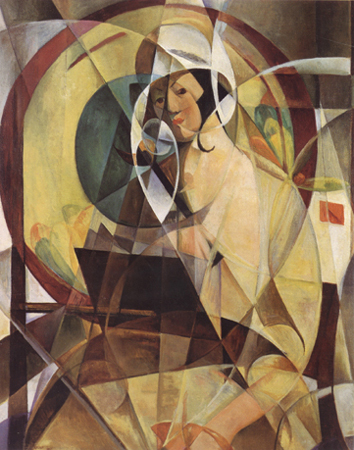Mary Swanzy
1882-1978
Mary Swanzy was born Dublin Ireland in1882.
Swanzy is considered to be the first Irish Cubist, preceding Evie Hone
and Mainie Jellet. Although not achieving mush recognition outside Ireland,
she is one of the most important Irish painters of the twentieth century.
Swanzy suffered from frail health as a child, but lived to age ninety-six.
She came from a distinguished professional family, which for the most
part, nurtured her artistic efforts. Her father, Sir Henry Rosborough
Swanzy, an ophthalmic surgeon was the vice-president of the College
of Surgeons. By the age of fifteen, she had drawn, painted, and attended
art classes for several years. At age fifteen, she left Ireland to complete
her studies at the Lycée in Versailles and later in Freiburg,
Germany.
Upon leaving these schools, Mary Swanzy pursued her career as a painter.
She took further art classes in Dublin and was greatly encouraged by
an instructor whose work she admired, the painter John B. Yeats. She
also studied sculpting at the Metropolitan School of Art in Dublin.
Pursuant to her father’s wish that she specialize in portraiture,
and following the example of Sarah Purser, another contemporary artist
whose work she respected, she produced portrait upon portrait. Swanzy
had a portrait accepted for exhibition by the Royal Hibernain Academy
in 1905.
Seeking constantly to expand her scope, Swanzy once again left for Paris
to study, this time with Delacluse, who had a studio for women. Then
in her mid-twenties, she was a disciplined student who drew and painted
all-day and attended sketching classes at night. In 1906, she attended
classes at the studio of the portrait painter, De La Grandara, at La
Grand Chaumiére and at Colarossi’s atelier. She arrived
in Paris when the cubist style was developing. She visited Gertrude
Stein’s salon, where she saw recent works by Picasso, Braque,
Matisse, Derain, Laurencin, Cézanne, and Gauguin.
Still struggling to establish herself, she returned to Dublin. Compared
with Paris, the artistic milieu at home seemed to her quite conservative,
modern art seemed not to have any impact. To support herself, she worked
as an illustrator. In 1913, she had her first solo exhibition at Mill’s
Hall, Dublin.
Mary Swanzy gained financial independence after she inherited much of
her parents’ estate. Desirous of a change in atmosphere, she left
for Italy. Paintings produced during her stay in Italy were exhibited
in 1914 at the Salon des Indépendants in Paris, together with
those of a Cubist group and of Delauney, whose Orphic-Cubist “Homage
to Blériot” influenced her development.
Judging from a photo of Mary Swanzy taken during her stay in France
after World War I, her “Woman with a White Bonnet” is very
likely a self-portrait. None of her paintings are dated, so it is impossible
to establish an exact chronology. But it seems certain that Swanzy executed
this painting only after her exposure to the Italian Futurists and to
the work of Delaunay. She employs the Cubist-Futurist fragmentation
of form to create a non-perspective sense of space combined with motion.
The interplay of colors with repetition of curves creates a lyrical
composition within the interplay of light and shadow.
Swanzy continued to exhibit her paintings and in 1916 at the 21st Exhibition
of the International Society of Sculptors, Painters, and Gravers at
the Grosvenor Gallery in London. In 1918, following the end of the war,
she exhibited again at the Salon des Indépendants in Paris. She
became a committee member of the Salon in 1920.
After 1920, Swanzy traveled to Czechoslovakia, Hawaii, Samoa, and California,
producing a body of work at each location. In 1926, she settled in Blackheath,
south London, where she lived for the rest of her life. A one-woman
show of her work was held at the Dublin painter’s Gallery in 1943.
She then participated in an important group show, which included the
works of Braque, Vlaminck, and Dufy at St. Georges’s Gallery,
London, in 1946. This exhibition was followed by a solo show at the
same gallery the year after. In 1968, when she was eighty-six, a major
Mary Swanzy retrospective was mounted by the municipal Gallery of Modern
Art in Dublin. In 1982, the same city hosted a centenary exhibition
for her.
|

